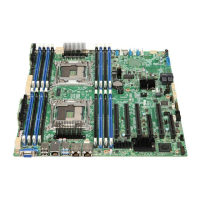Intel® Server Board S2600CW Family TPS Intel® Server Board S2600CW Functional Architecture
Revision 2.4
single threaded workloads. It should be enabled in the BIOS for the processor to operate with
maximum performance.
3.2.8 Enhanced Intel SpeedStep® Technology
The processor supports Enhanced Intel SpeedStep® Technology (EIST) as an advanced means
of enabling very high performance while also meeting the power conservation needs of the
platform.
Enhanced Intel SpeedStep® Technology builds upon that architecture using design strategies
that include the following:
Separation between Voltage and Frequency changes. By stepping voltage up and down
in small increments separately from frequency changes, the processor is able to reduce
periods of system unavailability (which occur during frequency change). Thus, the
system is able to transition between voltage and frequency states more often,
providing improved power/performance balance.
Clock Partitioning and Recovery. The bus clock continues running during state
transition, even when the core clock and Phase-Locked Loop are stopped, which allows
logic to remain active. The core clock is also able to restart more quickly under
Enhanced Intel SpeedStep® Technology.
3.2.9 Intel® Advanced Vector Extensions 2 (Intel® AVX2)
Intel® Advanced Vector Extensions 2.0 (Intel® AVX2) is the latest expansion of the Intel
instruction set. Intel® AVX2 extends the Intel® Advanced Vector Extensions (Intel® AVX) with
256-bit integer instructions, floating-point fused multiply add (FMA) instructions and gather
operations. The 256-bit integer vectors benefit math, codec, image and digital signal
processing software. FMA improves performance in face detection, professional imaging, and
high performance computing. Gather operations increase vectorization opportunities for many
applications. In addition to the vector extensions, this generation of Intel processors adds new
bit manipulation instructions useful in compression, encryption, and general purpose
software.
3.2.10 Intel® Node Manager 3.0
Intel® Node Manager 3.0 enables the PTAS-CUPS (Power Thermal Aware Scheduling –
Compute Usage Per Second) feature of the Intel® Server Platform Services 3.0 Intel® ME FW.
This is in essence a grouping of separate platform functionalities that provide Power, Thermal,
and Utilization data that together offer an accurate, real time characterization of server
workload. These functionalities include the following:
Computation of Volumetric Airflow
New synthesized Outlet Temperature sensor
CPU, memory, and I/O utilization data (CUPS)

